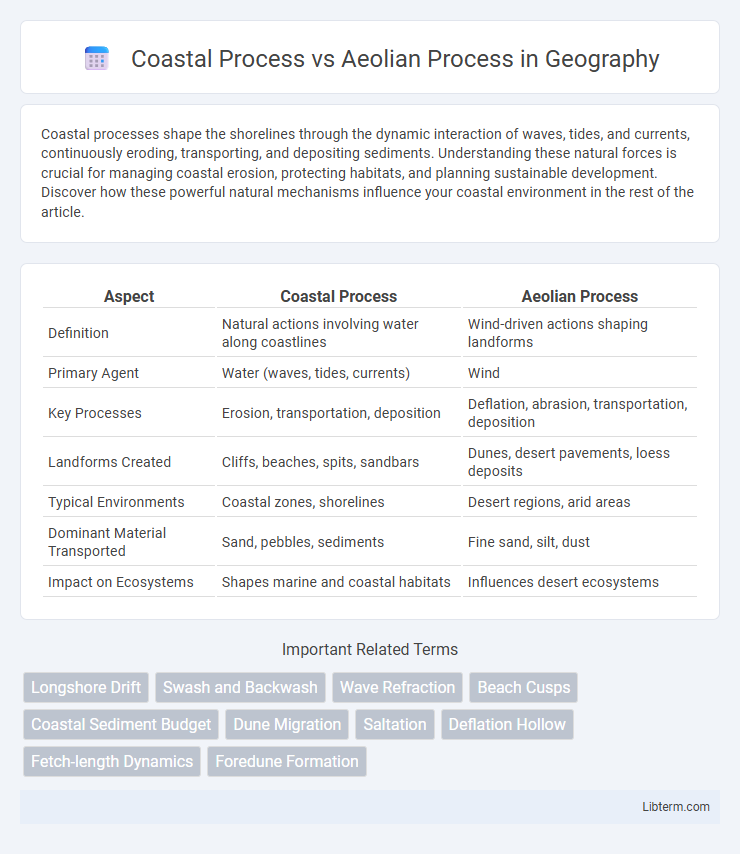Coastal processes shape the shorelines through the dynamic interaction of waves, tides, and currents, continuously eroding, transporting, and depositing sediments. Understanding these natural forces is crucial for managing coastal erosion, protecting habitats, and planning sustainable development. Discover how these powerful natural mechanisms influence your coastal environment in the rest of the article.
Table of Comparison
| Aspect | Coastal Process | Aeolian Process |
|---|---|---|
| Definition | Natural actions involving water along coastlines | Wind-driven actions shaping landforms |
| Primary Agent | Water (waves, tides, currents) | Wind |
| Key Processes | Erosion, transportation, deposition | Deflation, abrasion, transportation, deposition |
| Landforms Created | Cliffs, beaches, spits, sandbars | Dunes, desert pavements, loess deposits |
| Typical Environments | Coastal zones, shorelines | Desert regions, arid areas |
| Dominant Material Transported | Sand, pebbles, sediments | Fine sand, silt, dust |
| Impact on Ecosystems | Shapes marine and coastal habitats | Influences desert ecosystems |
Introduction to Coastal and Aeolian Processes
Coastal processes involve the movement and shaping of shorelines through wave action, tides, and sediment transport, critically influencing coastal landforms such as beaches, dunes, and estuaries. Aeolian processes refer to the erosion, transport, and deposition of sediments by wind, significantly impacting desert landscapes, sand dunes, and loess deposits. Both processes are key drivers in geomorphology, shaping terrestrial and marine environments through distinct yet interrelated sediment dynamics.
Defining Coastal Processes
Coastal processes involve the dynamic actions of waves, tides, and currents that shape shorelines through erosion, transportation, and deposition of sediments. These processes create distinct landforms such as beaches, cliffs, and estuaries by continuously modifying coastal landscapes. Understanding coastal processes is essential for managing erosion, habitat preservation, and human activities along seaboards.
Understanding Aeolian Processes
Aeolian processes involve the transport and deposition of sediment by wind, shaping landforms such as dunes and loess deposits in arid and semi-arid regions. Unlike coastal processes driven primarily by wave action and tidal forces, aeolian mechanisms rely on wind velocity, sediment availability, and surface roughness to influence erosion and sedimentation patterns. Understanding aeolian processes is crucial for managing desertification, maintaining agricultural productivity, and predicting landscape changes in habitats sensitive to wind-driven sediment dynamics.
Key Agents of Erosion: Water vs Wind
Coastal processes predominantly rely on water as the key agent of erosion, where waves, tides, and currents shape shorelines by transporting sediments and eroding rock formations. Aeolian processes involve wind as the primary erosive force, carrying fine particles like sand and dust to sculpt landscapes such as dunes and desert pavements. Understanding the differential impact of water and wind erosion helps in managing coastal and arid environments effectively.
Sediment Transport in Coastal Environments
Coastal processes involve the movement of sediments primarily through wave action, tides, and currents, reshaping shorelines via mechanisms like longshore drift and storm surges. Aeolian processes in coastal environments refer to the wind-driven transport of sediment, especially sand, forming features such as dunes and sand sheets that stabilize or reshape coastal landscapes. The interplay between coastal and aeolian sediment transport is critical in maintaining beach morphology and protecting against erosion in dynamic shoreline ecosystems.
Sediment Transport in Aeolian Environments
Sediment transport in aeolian environments primarily occurs through processes like saltation, suspension, and surface creep, driven by wind energy that lifts and moves particles across landscapes such as deserts and beaches. Unlike coastal processes where water dynamics dominate sediment movement through waves, tides, and currents, aeolian sediment transport depends on wind velocity, grain size, and surface moisture, all critical factors influencing dune formation and desertification rates. Understanding these mechanisms is essential for predicting sediment flux, managing land degradation, and preserving habitats in arid and semi-arid regions.
Landforms Created by Coastal Processes
Coastal processes shape diverse landforms such as beaches, spits, barrier islands, and estuaries through the action of waves, tides, and currents that erode, transport, and deposit sediments along shorelines. Features like sea cliffs, wave-cut platforms, and arches result from the persistent erosion by hydraulic action and abrasion. Coastal deposition forms landforms like sand dunes, lagoons, and tidal flats, distinct from aeolian processes primarily driven by wind that create desert dunes and loess deposits.
Landforms Created by Aeolian Processes
Aeolian processes primarily shape landforms through the action of wind transporting and depositing sediment, creating distinctive features such as dunes, loess plains, and yardangs. Coastal processes, in contrast, involve wave action, tides, and currents that form beaches, spits, barrier islands, and tidal flats. Aeolian landforms are characterized by their fine-grained sediment composition and occur predominantly in arid and semi-arid regions where vegetation is sparse.
Comparing Impacts on Regional Landscapes
Coastal processes shape regional landscapes through wave action, tides, and currents, creating features like cliffs, beaches, and estuaries that influence sediment distribution and habitat diversity. Aeolian processes, dominated by wind erosion and deposition, form dunes, loess plains, and desert pavements, significantly altering arid and semi-arid environments. Comparing impacts reveals that coastal processes primarily affect moisture-rich zones with dynamic shorelines, while aeolian processes drive landscape evolution in dry regions by redistributing fine sediments and influencing soil formation.
Human Influence on Coastal and Aeolian Dynamics
Human activities such as urban development, dam construction, and shoreline armoring significantly alter coastal processes by disrupting sediment supply and natural erosion patterns. In aeolian environments, land use changes like agriculture, deforestation, and off-road vehicle traffic increase soil erosion and modify dune dynamics by destabilizing vegetation cover. Coastal and aeolian systems respond to these anthropogenic influences through altered sediment transport rates, which can intensify vulnerability to storms and desertification.
Coastal Process Infographic

 libterm.com
libterm.com